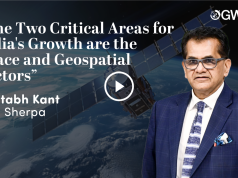History of civilization is the story of mapping evolution, from papyrus to the forthcoming era of HD maps. The power of maps spells our choices, constraints, and lays down pathways.
“First maps came into existence when sketches were geographically referenced”, says Hitesh Makwana, Surveyor General, Survey of India (SOI).
With the advent of digitalization and increasing private sector participation, map-making and geodata management have transformed as well. This has led to increasing democratization of cartographic information, as well as SOI devolving many of its traditional roles and supporting the fledgling private sector.
“With the maturity of the private sector, gradually SOI will scale down from many areas. However, we will continue the modernization of geodetic data, and offer ortho-rectified imagery, and digital elevation models”
“Agility and giving opportunities to the private sector is important these days. 30,000 manpower we have reduced to 3,000”
Conducive Policy
The Surveyor General believes that new opportunities are coming up in the geospatial sector, especially after the National Geospatial Policy,
“Geospatial policy has liberated us from many archaic colonial era norms”, says Rakesh Varma, CEO, MapyINDIA.
“While the government is spending money on geospatial, there’s a need to support products and platforms mainly by MSMEs. GDPDC and Survey of India can work with the government for a hand-holding mechanism”, he adds.
While the policy is in the right direction there’s a need for a feedback loop, says Krishanu Acharya, CEO, Suhora.
He believes that Indian companies should not be restricted but allowed to venture overseas as well.
Global Push
Rakesh Varma believes that if proper hand-holding and support is provided to Indian geospatial companies they have the potential to become truly global MNCs.
“We collaborate with the National Remote Sensing Centre( NRSC). NASA satellite imagery, analyzed by NRSC and downloaded by us. This is an example of global collaboration”, says Anoop Singh, Director General, the Forest Survey of India
Problem-Solving Approach
There’s a need to be more people-centric to foster greater collaborations and look at newer opportunities.
Dr. SP Agarwal, Director, North East Space Application Centre, thinks out loud on the use-cases of geospatial across sectors to solve problems afflicting the citizens.
He cites the example of traffic congestion in Aizwal, Mizoram, and explores how we can look into how geospatial to solve it.
System Integrators
“Space, geospatial, and drones all need to be thought out together as real-life use cases. We need to push the pedal towards achieving a 5 trillion dollar economy”, states Saurabh Rai, CEO, Arahas Technologies.
He also emphasized the need to develop local system integrators in India and gain more investor confidence.
“Discourse has shifted from data piracy to data privacy, data security to data democratization. With these, there is no dearth of new funding, but we need to showcase the value of what we are doing”, he adds.





